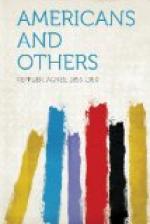The symbolism of dress is a subject which has never received its due share of attention, yet it stands for attributes in the human race which otherwise defy analysis. It is interwoven with all our carnal and with all our spiritual instincts. It represents a cunning triumph over hard conditions, a turning of needs into victories. It voices desires and dignities without number, it subjects the importance of the thing done to the importance of the manner of doing it. “Man wears a special dress to kill, to govern, to judge, to preach, to mourn, to play. In every age the fashion in which he retains or discards some portion of this dress denotes a subtle change in his feelings.” All visible things are emblematic of invisible forces. Man fixed the association of colours with grief and gladness, he made ornaments the insignia of office, he ordained that fabric should grace the majesty of power.
Yet though we know this well, it is our careless custom to talk about dress, and to write about dress, as if it had no meaning at all; as if the breaking waves of fashion which carry with them the record of pride and gentleness, of distinction and folly, of the rising and shattering of ideals,—“the cut which betokens intellect and talent, the colour which betokens temper and heart,”—were guided by no other law than chance, were a mere purposeless tyranny. Historians dwell upon the mad excesses of ruff and farthingale, of pointed shoe and swelling skirt, as if these things stood for nothing in a society forever alternating between rigid formalism and the irrepressible spirit of democracy.
Is it possible to look at a single costume painted by Velasquez without realizing that the Spanish court under Philip the Fourth had lost the mobility which has characterized it in the days of Ferdinand and Isabella, and had hardened into a formalism, replete with dignity, but lacking intelligence, and out of touch with the great social issues of the day? French chroniclers have written page after page of description—aimless and tiresome description, for the most part—of those amazing head-dresses which, at the court of Marie Antoinette, rose to such heights that the ladies looked as if their heads were in the middle of their bodies. They stood seven feet high when their hair was dressed, and a trifle over five when it wasn’t. The Duchesse de Lauzun wore upon one memorable occasion a head-dress presenting a landscape in high relief on the shore of a stormy lake, ducks swimming on the lake, a sportsman shooting at the ducks, a mill which rose from the crown of her head, a miller’s wife courted by an abbe, and a miller placidly driving his donkey down the steep incline over the lady’s left ear.




